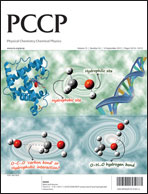Remarkable magnetism and ferromagnetic coupling in semi-sulfuretted transition-metal dichalcogenides
Abstract
Motivated by recent investigations of semi-decorated two dimensional honeycomb structures, we demonstrated, via spin-polarized molecular-dynamics simulations and density-functional-theory calculations, that semi-sulfuretted transition-metal dichalcogenides of MX type (M = V, Nb, Ta; X = S, Se, Te) are stable and display remarkable magnetism. The unpaired d electron of the transition-metal atom arising from the breakage of the M–X bond is the mechanism behind the induction of the magnetism. The remarkable magnetism of the transition-metal atoms is caused by ferromagnetic coupling due to the competitive effects of through-bond interactions and through-space interactions. This implies the existence of an infinite ferromagnetic sheet with structural integrity and magnetic homogeneity. The estimated Curie temperatures suggest that the ferromagnetism can be achieved above room temperature in the VS, VSe, VTe, NbTe and TaTe sheets. Depending on the species of the M and X atoms, the MX sheet can be a magnetic metal, magnetic semiconductor or half-metal. Furthermore, in contrary to the recently reported semi-hydrogenated and semi-fluorinated layered materials consisting of B, C, N, etc., the MX sheets with many unpaired d electrons can offer a much stronger spin polarization and possess a more stable ferromagnetic coupling, which is critical for practical nanoscale device applications.


 Please wait while we load your content...
Please wait while we load your content...